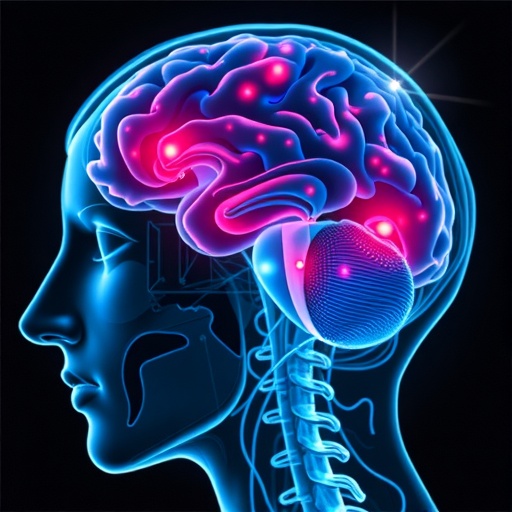In a groundbreaking clinical case that challenges previous understandings of autoimmune encephalitis, researchers have documented a rare presentation of anti-alpha-amino-3-hydroxy-5-methyl-4-isoxazolepropionic acid receptor (AMPAR) encephalitis manifesting primarily as catatonia. This finding, published in BMC Psychiatry, offers new insights into the complex neuroimmunological pathways that underlie psychomotor disorders and expands the diagnostic considerations for clinicians encountering catatonic states.
Catatonia, a psychomotor syndrome characterized by a constellation of features such as mutism, stereotypic movements, posturing, waxy flexibility, and echophenomena, has traditionally been associated with psychiatric disorders or neurological conditions, including anti-N-methyl-D-aspartate receptor (NMDAR) encephalitis. NMDAR encephalitis is well-known for its antibody-mediated disruption of glutamatergic transmission, primarily through the internalization of NMDARs, causing a cascade of neuropsychiatric symptoms. However, the occurrence of catatonia in association with anti-AMPAR encephalitis has been documented scarcely, rendering this case highly significant for neurologists and psychiatrists alike.
The reported case involves a 56-year-old Japanese woman who initially presented with nonspecific symptoms of headache and fever, progressing rapidly to an unresponsive state reminiscent of catatonic stupor. Clinically, she exhibited resistance to passive eye-opening, an avoidance reaction during the arm drop test, and a lack of withdrawal to painful stimuli. Such neurological signs are often subtle and may be overlooked without a high index of suspicion, highlighting the importance of thorough neurological examination in cases with enigmatic presentations.
Diagnostic workup revealed inflammatory changes in the cerebrospinal fluid (CSF), notably pleocytosis and an elevated Immunoglobulin G (IgG) index, though without the presence of oligoclonal bands restricted to the CSF compartment. Magnetic resonance imaging (MRI) demonstrated bilateral medial temporal lobe lesions alongside two small lesions in the cerebellum, suggesting multifocal involvement. Electroencephalography (EEG) patterns fluctuated between frontal predominant delta waves and frontocentral theta activity, while single-photon emission computed tomography (SPECT) indicated hypoperfusion predominantly in the right frontal regions, all of which underscore the diffuse cerebral dysfunction.
What sets this case apart is the immunological profiling. While antibodies targeting NMDAR subunits were absent, tissue-based assays revealed strong reactivity to neuronal surface antigens consistent with AMPAR involvement. This was confirmed by the detection of AMPAR antibodies in both the CSF and serum. The absence of other neuronal surface antibodies and the lack of malignancy, often associated with paraneoplastic limbic encephalitis, isolated anti-AMPAR encephalitis as the definitive diagnosis.
Therapeutically, the patient responded favorably to immunomodulatory interventions consisting of high-dose intravenous methylprednisolone, tapered oral prednisolone, and intravenous immunoglobulin therapy administered over several cycles. Her symptoms, including the catatonic state, improved gradually over two months—a timeline that reflects potential reversibility of antibody-mediated synaptic dysfunctions when promptly treated.
This case carries profound implications for the understanding of autoimmune encephalitis phenotypes. Traditionally, anti-AMPAR encephalitis is not prominently associated with profound psychomotor disturbances such as catatonia. The mechanisms postulated involve antibody-driven cross-linking and internalization of AMPARs, integral to excitatory glutamatergic synaptic transmission, particularly in the frontal lobes. Such disruption could feasibly result in the neurobehavioral and motor abnormalities observed, suggesting that the glutamatergic system’s impairment underlies catatonic features.
The rarity of catatonia as a clinical manifestation in anti-AMPAR encephalitis calls for heightened vigilance during assessment. Clinicians should consider anti-AMPAR encephalitis in differential diagnoses of catatonia, especially when hallmark symptoms of anti-NMDAR encephalitis, such as orofacial dyskinesia and autonomic instability, are absent, and MRI findings do not align with typical anti-NMDAR patterns. Early identification and aggressive immunotherapy may prevent irreversible neuronal damage and improve functional outcomes.
Moreover, this case emphasizes the necessity for comprehensive antibody screening using tissue-based assays beyond standard panels. Detecting antibodies against a spectrum of neuronal surface antigens may uncover elusive diagnoses, guiding targeted immunotherapy and prognostication.
From a neuroscience perspective, this case enriches the conceptual framework linking antibody-mediated synaptic receptor dysfunction to distinct neuropsychiatric phenotypes. It prompts a reevaluation of catatonia not merely as a psychiatric or idiopathic syndrome but as a possible manifestation of underlying synaptic receptor autoimmunity. Future research should explore the prevalence of AMPAR antibodies in catatonic patients and investigate the molecular pathways through which these antibodies perturb cortical circuits.
Furthermore, the observation of alternating EEG delta and theta activities alongside frontal hypoperfusion on SPECT suggests dynamic functional disturbances in cortical and subcortical networks during catatonic episodes. These neurophysiological markers may ultimately aid in monitoring disease progression and response to therapy.
This study also raises intriguing questions regarding the pathophysiology of glutamatergic receptor internalization mechanisms unique to AMPAR antibodies and their potential cross-talk with other neurotransmitter systems implicated in movement and affective regulation. Understanding these intricacies might open avenues for novel therapeutic targets beyond immunosuppression.
In conclusion, the documentation of catatonia as an initial and prominent clinical clue in anti-AMPAR encephalitis reshapes the diagnostic landscape of autoimmune neuropsychiatric disorders. It underscores the imperative for a multidisciplinary approach combining detailed clinical evaluation, advanced neuroimaging, electrophysiology, and precise immunological testing to unravel complex cases. This integrative strategy will enhance diagnostic accuracy, expedite treatment initiation, and ultimately improve patient outcomes in a domain where early intervention is paramount.
Subject of Research: Autoimmune encephalitis; neuroimmunology; catatonia; AMPAR antibody-mediated synaptic dysfunction
Article Title: Anti-alpha-amino-3-hydroxy-5-methyl-4-isoxazolepropionic acid receptor encephalitis presenting as catatonia
Article References:
Nakagawa, Y., Sugiyama, A., Yasuda, M. et al. Anti-alpha-amino-3-hydroxy-5-methyl-4-isoxazolepropionic acid receptor encephalitis presenting as catatonia. BMC Psychiatry 25, 712 (2025). https://doi.org/10.1186/s12888-025-07185-5
Image Credits: AI Generated




